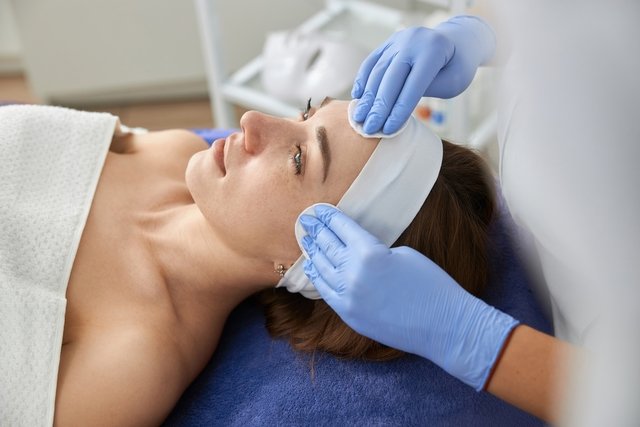Phenol peeling is an aesthetic treatment in which an acid is applied to the skin capable of removing the outermost layer. Phenol peeling helps promote the growth of smoother and more uniform skin, especially in cases where there are signs of the effects of sun radiation, the presence of more pronounced wrinkles, sagging, scars and blemishes, providing good results with just one application. .
Compared to other chemical peelings, phenol peeling is more intense and aggressive, so both its application and recovery must be closely monitored by a dermatologist, so as not to cause damage to the skin, in addition to other possible risk factors, such as complications. cardiac for example.
The criteria for applying phenol peeling may include the patient’s age, the area to be treated, the degree of photoaging, the treatment objectives, each person’s risk factors and phototype, with lighter skin. the most suitable for this type of procedure.

What is it for
Phenol peeling is used for:
- Facial rejuvenation;
- Even out the skin;
- Eliminate stains;
- Reduce sagging;
- Smooth expression lines.
As it is a peeling considered deep and painful, which requires medical monitoring, the indication to carry out the procedure requires a prior evaluation by the dermatologist, who will understand the need for the procedure and whether the person meets the inclusion criteria for applying the acid. , with phenol peeling being recommended for older skin with a lighter phototype.
How to prepare
As it is a very aggressive procedure, before opting for phenol peeling, the doctor must be informed about clinical conditions related to the heart, kidney or liver, or any cosmetic procedures that have been used in the past. The preparation must be guided by the dermatologist and consists of:
- Avoid sun exposure, applying sunscreen daily, at least four weeks before the peel, to help prevent uneven pigmentation in areas to be treated. Check out the best sunscreen for each skin type;
- Avoid aesthetic treatmentssuch as microneedling, carboxytherapy or even other milder peelings, such as mandelic acid, for example, so that the skin is not so exposed and at risk of showing blemishes;
- Avoid waxing or shavingin the week before treatment, to avoid damaging the skin and causing spots, after applying phenol;
- Avoid exfoliating your skin the week before, to keep the skin intact and not show damage after applying the acid.
The continuous use of medication or the follow-up of a recent treatment, especially those that make the skin more sensitive to the sun, must be reported to the doctor to avoid interactions or worsening recovery after the procedure.
How is done
Phenol peeling is performed by a dermatologist, under carefully monitored conditions and in a hospital environment. The patient undergoes sedation and local anesthesia to alleviate discomfort, and the heart rate is also monitored.
The face is divided into areas, respecting an interval of approximately 15 minutes in each region, and the complete facial procedure can take around 90 minutes.
With the skin already clean and free of oil, the acid is applied with cotton or gauze, without using vigorous movements, as the acid may penetrate more quickly, which could result in poisoning.
Before and after phenol peeling
There is a significant difference in the skin before and after applying the acid. After phenol peeling, a great improvement can be seen in the appearance of the treated areas, revealing a new layer of smooth skin, providing important rejuvenation. After healing is complete, the skin becomes clearer and more luminous, less flaccid and the appearance of deep wrinkles and severe pigmentation is noticeably reduced.
Although the results can last for decades, making a person look younger, they may not be permanent. As you age, the signs of time will become more evident and contribute to the appearance of new expression lines, as well as sun damage, which can reverse your results and cause changes in skin color.
What is recovery like?
As it is a very deep treatment, which results in redness, intense peeling, facial swelling and a burning sensation, phenol peeling has a long and uncomfortable recovery, compared to other types of peeling, and can last around 3 months for a complete restoration of the skin. Recovery begins immediately after the procedure, requiring close observation and assessment of the patient in the first 4 hours.
Many side effects can be minimized if medical instructions are strictly followed, such as:
- Sleep in a position that helps reduce swelling, avoiding direct contact of the face with any surface;
- Use medications prescribed by the medical team, such as painkillers, in addition to cold compresses;
- Avoid sun exposure for around three months after the peeling, as the skin is sensitive and without the necessary protection, and it is essential to use sun protection before leaving home;
- Keep your skin clean and hydrated. Discover some moisturizing mask options for your face.
All products used on the skin after treatment must be guided by the responsible professional.
Furthermore, it is recommended to pay attention to signs and symptoms that may appear in the days following the procedure, such as fever, intense itching or presence of secretion, for example, and, if this occurs, it is essential to seek help to start treatment immediately.
Who shouldn’t do
Carrying out phenol peeling is not recommended in some situations, the main ones being:
- Pregnancy;
- Lactation;
- Active herpetic lesions;
- Bacterial or fungal infection;
- Facial dermatitis;
- Use of photosensitizing medications;
- Allergies to peeling components;
- Heart problems.
Furthermore, people who have had acne treatments with isotretinoin in the last 6 months should also not opt for this type of peeling.
This procedure can cause scars and changes in skin color, with darkening of the skin being more common with this type of peeling. Therefore, it is important to orient yourself regarding the possible effects and expected results.

Sign up for our newsletter and stay up to date with exclusive news
that can transform your routine!
Warning: Undefined array key "title" in /home/storelat/public_html/wp-content/plugins/link-whisper-premium/templates/frontend/related-posts.php on line 12
Warning: Undefined array key "title_tag" in /home/storelat/public_html/wp-content/plugins/link-whisper-premium/templates/frontend/related-posts.php on line 13



